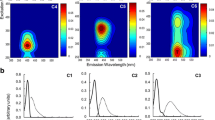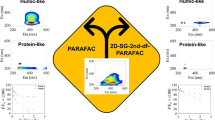Abstract
Rapid monitoring of water quality is crucial to the operation of municipal wastewater treatment plants (WWTPs). Fluorescence excitation-emission matrix (EEM) in combination with parallel factor analysis (PARAFAC) has been used as a powerful tool for the characterization of dissolved organic matter (DOM) in WWTPs. However, a recent work has revealed the drawback of PARAFAC analysis, i.e., overestimating the component number. A novel method, parallel factor framework-clustering analysis (PFFCA), has been developed in our earlier work to resolve this drawback of PARAFAC. In the present work, both PARAFAC and PFFCAwere used to analyze the EEMs of water samples from a full-scale WWTP from a practical application point of view. The component number and goodness-offit from these two methods were compared and the relationship between the relative score change of component and the actual concentration was investigated to evaluate the estimation error introduced by both methods. PFFCA score and actual concentration exhibited a higher correlation coefficient (R 2 = 0.870) compared with PARAFAC (R 2<0.771), indicating that PFFCA provided a more accurate relative change estimation than PARAFAC. The results suggest that use of PARAFAC may cause confusion in selecting the component number, while EEM-PFFCA is a more reliable alternative approach for monitoring water quality in WWTPs.

Similar content being viewed by others
References
Henderson R K, Baker A, Murphy K R, Hambly A, Stuetz R M, Khan S J. Fluorescence as a potential monitoring tool for recycled water systems: a review. Water Research, 2009, 43(4): 863–881
Yang L, Han D H, Lee B M, Hur J. Characterizing treated wastewaters of different industries using clustered fluorescence EEM-PARAFAC and FT-IR spectroscopy: implications for downstream impact and source identification. Chemosphere, 2015, 127: 222–228
Bourgeois W, Burgess J E, Stuetz R M. On-line monitoring of wastewater quality: a review. Journal of Chemical Technology and Biotechnology (Oxford, Oxfordshire), 2001, 76(4): 337–348
He W, Chen S, Liu X, Chen J. Water quality monitoring in a slightly-polluted inland water body through remote sensing—Case study of the Guanting Reservoir in Beijing, China. Frontiers of Environmental Science & Engineering, 2008, 2(2): 163–171
Tartakovsky B, Lishman L A, Legge R L. Application of multiwavelength fluorometry for monitoring wastewater treatment process dynamics. Water Research, 1996, 30(12): 2941–2948
Reynolds D M, Ahmad S R. Rapid and direct determination of wastewater BOD values using a fluorescence technique. Water Research, 1997, 31(8): 2012–2018
Zhou Y, Xia S Q, Nguyen B T, Long M, Zhang J, Zhang Z Q. Interactions between metal ions and the biopolymer in activated sludge: quantification and effects of system pH value. Frontiers of Environmental Science & Engineering, 2017, 11(1): 7
Xue S, Zhao Q L,Wei L L, Hui X J, Ma X P, Lin Y Z. Fluorescence spectroscopic studies of the effect of granular activated carbon adsorption on structural properties of dissolved organic matter fractions. Frontiers of Environmental Science & Engineering, 2012, 6(6): 784–796
Guo J, Sheng F, Guo J H, Yang X, Ma M T, Peng Y Z. Characterization of the dissolved organic matter in sewage effluent of sequence batch reactor: the impact of carbon source. Frontiers of Environmental Science & Engineering, 2012, 6(2): 280–287
Ishii S K L, Boyer T H. Behavior of reoccurring PARAFAC components in fluorescent dissolved organic matter in natural and engineered systems: a critical review. Environmental science & technology, 2012, 46(4): 2006–2017
Yamashita Y, Jaffé R. Characterizing the interactions between trace metals and dissolved organic matter using excitation-emission matrix and parallel factor analysis. Environmental Science & Technology, 2008, 42(19): 7374–7379
Murphy K R, Hambly A, Singh S, Henderson R K, Baker A, Stuetz R, Khan S J. Organic matter fluorescence in municipal water recycling schemes: toward a unified PARAFAC model. Environmental Science & Technology, 2011, 45(7): 2909–2916
Carstea E M, Bridgeman J, Baker A, Reynolds D M. Fluorescence spectroscopy for wastewater monitoring: a review. Water Research, 2016, 95: 205–219
Fang F, Yang Y, Guo J S, Zhou H, Fu C, Li Z. Three-dimensional fluorescence spectral characterization of soil dissolved organic matters in the fluctuating water-level zone of Kai County, Three Gorges Reservoir. Frontiers of Environmental Science & Engineering, 2011, 5(3): 426–434
Li W H, Sheng G P, Liu X W, Yu H Q. Characterizing the extracellular and intracellular fluorescent products of activated sludge in a sequencing batch reactor. Water Research, 2008, 42(12): 3173–3181
Stedmon C A, Bro R. Characterizing dissolved organic matter fluorescence with parallel factor analysis: a tutorial. Limnology and Oceanography, Methods, 2008, 6(11): 572–579
Andersen C M, Bro R. Practical aspects of PARAFAC modeling of fluorescence excitation-emission data. Journal of Chemometrics, 2003, 17(4): 200–215
Cohen E, Levy G J, Borisover M. Fluorescent components of organic matter in wastewater: efficacy and selectivity of the water treatment. Water Research, 2014, 55: 323–334
Ou H S, Wei C H, Mo C H, Wu H Z, Ren Y, Feng C H. Novel insights into anoxic/aerobic1/aerobic2 biological fluidized-bed system for coke wastewater treatment by fluorescence excitationemission matrix spectra coupled with parallel factor analysis. Chemosphere, 2014, 113: 158–164
Rosario-Ortiz F L, Korak J A. Oversimplification of dissolved organic matter fluorescence analysis: potential pitfalls of current methods. Environmental Science & Technology, 2017, 51(2): 759–761
Del Vecchio R, Blough N V. On the origin of the optical properties of humic substances. Environmental Science & Technology, 2004, 38(14): 3885–3891
Qian C, Wang L F, Chen W, Wang Y S, Liu X Y, Jiang H, Yu H Q. Fluorescence approach for the determination of fluorescent dissolved organic matter. Analytical Chemistry, 2017, 89(7): 4264–4271
Ni B J, Xie W M, Liu S G, Yu H Q, Wang Y Z, Gan W, Dai X L. Modeling and simulation of the sequencing batch reactor at a fullscale municipal wastewater treatment plant. American Institute of Chemical Engineers, 2009, 55(8): 2186–2196
APHA. Standard Methods for Examination of Water & Wastewater, 20th ed. Washingtong DC, USA: American Public Health Association, 1998
Lakowicz J R. Fluorescence Quenching: Theory and Applications, 2nd Ed. New York, NY: Kluwer Academic/Plenum, 1991
Andersson C A, Bro R. The N-way toolbox for MATLAB. Chemometrics and Intelligent Laboratory Systems, 2000, 52(1): 1–4
Le C, Kunacheva C, Stuckey D C. “Protein” measurement in biological wastewater treatment systems: a critical evaluation. Environmental Science & Technology, 2016, 50(6): 3074–3081
Acknowledgements
We thank the National Natural Science Foundation of China (Grant No. 51538011), the Collaborative Innovation Center of Suzhou Nano Science and Technology of the Ministry of Education of China for the support of this study.
Author information
Authors and Affiliations
Corresponding author
Electronic supplementary material
Rights and permissions
About this article
Cite this article
Qian, C., Chen, W., Li, WH. et al. A chemometric analysis on the fluorescent dissolved organic matter in a full-scale sequencing batch reactor for municipal wastewater treatment. Front. Environ. Sci. Eng. 11, 12 (2017). https://doi.org/10.1007/s11783-017-0962-2
Received:
Revised:
Accepted:
Published:
DOI: https://doi.org/10.1007/s11783-017-0962-2




